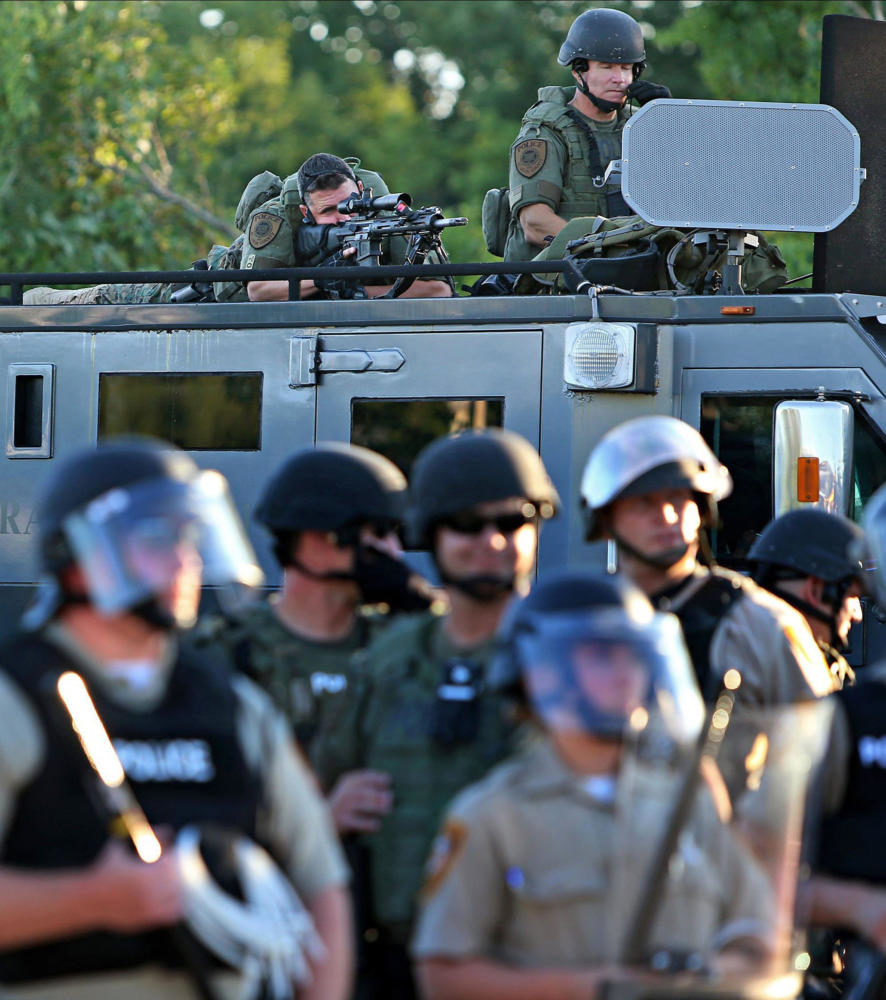Trump ending restrictions on grants of military gear to local police
A police sharpshooter keeps an eye on protesters along W. Florissant Avenue on Tuesday, Aug. 12, 2014, in Ferguson, Mo. (David Carson/St. Louis Post-Dispatch/TNS)
August 28, 2017
President Donald Trump will again allow the Pentagon to distribute surplus armored vehicles, grenade launchers and large-caliber weapons to local police, as well as make it easier for law enforcement agencies to obtain military-grade explosives and drones, administration officials said.
Although the Defense Department controls the military surplus program, the policy reversal was announced Monday morning by Attorney General Jeff Sessions, who has pushed to restore tough-on-crime policies and remove what he sees as shackles on law enforcement.
Under the program, created by Congress in 1990, local law enforcement agencies have received $6 billion worth of military gear, including tracked vehicles and heavy weapons used by SWAT tactical teams.
Advertisement
The program has come under sharp criticism for weak controls and poor oversight.
In July, a report by the Government Accountability Office said an investigator set up a phony police department and, with fake identification, was able to pick up $1.2 million worth of equipment from Defense Logistics Agency warehouses without any trouble — including night vision goggles and fake pipe bombs used in training.
The report called on the Defense Logistics Agency to improve its internal controls, saying it “lacked reasonable assurance that it has the ability to prevent, detect, and respond to potential fraud and minimize associated security risks.”
The distribution of the surplus military equipment to local police hit the headlines three years ago when Ferguson, Mo., erupted in violent protests after a policeman shot and killed an unarmed black man, Michael Brown.
Police responded to the protests with military weapons and armored vehicles — sparking a public outcry and criticism that the federal government had gone too far in militarizing local police departments. Congressional committees held hearings but ultimately passed no new legislation to change the program.
In 2015, President Barack Obama announced that he would end the grants of armored vehicles, grenade launchers and high-powered weaponry like .50-caliber rifles to law enforcement.
“We’ve seen how militarized gear can sometimes give people a feeling that there’s an occupying force, as opposed to a force that’s part of the community that’s protecting them and serving them” he said. “It can alienate and intimidate local residents and send the wrong message.”
Advertisement*
As of November, the Defense Department had recalled 126 armored personnel carriers, 138 grenade launchers and more than 1,600 bayonets, which the department described as “effectively heavy-duty knives with a single blade several inches long.”
Some police groups protested, saying the restrictions were a misguided approach that put a concern about appearances above officer and public safety.
During the presidential campaign, Trump vowed to scrap Obama’s restrictions, calling them “ridiculous” and praising the grants as “an excellent program that enhances public safety.”
A lawyer with the American Civil Liberties Union said that, given the GAO’s findings, the Trump administration should be working to improve controls on the program instead of loosening them.
“It’s just hard to fathom that bringing weapons of war into our communities for policing enhances public safety,” said Kanya Bennett, an ACLU legislative counsel. “We’ve seen that it does not.”
___
(c)2017 Los Angeles Times
Visit Los Angeles Times at www.latimes.com
Distributed by Tribune Content Agency, LLC.
Advertisement








